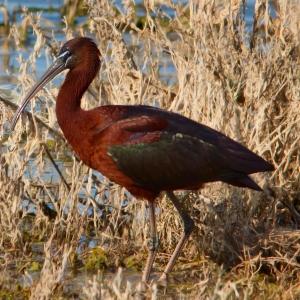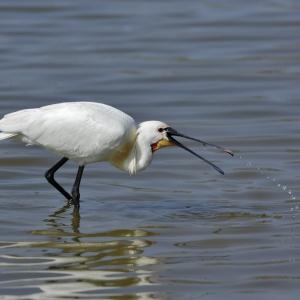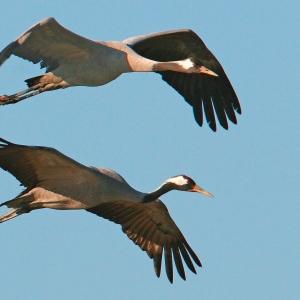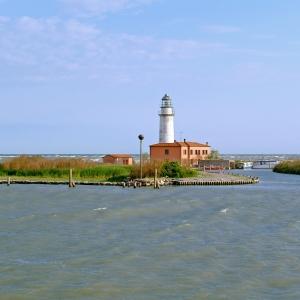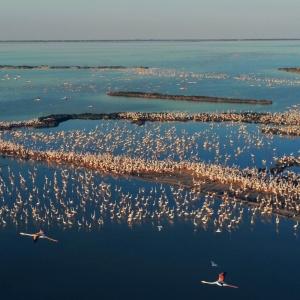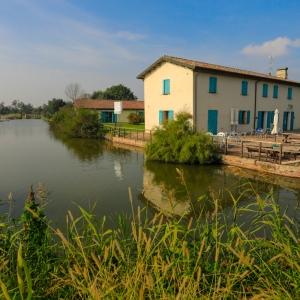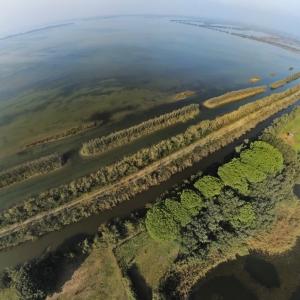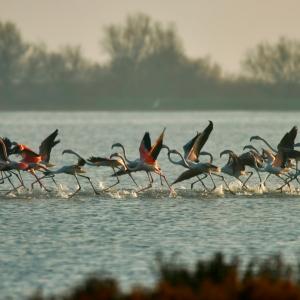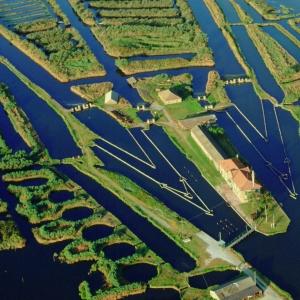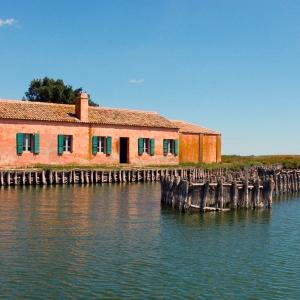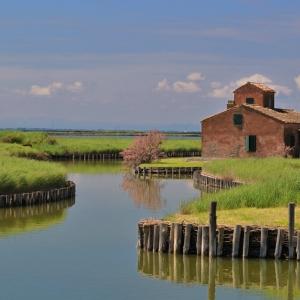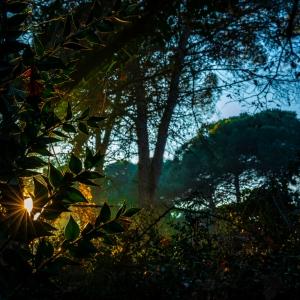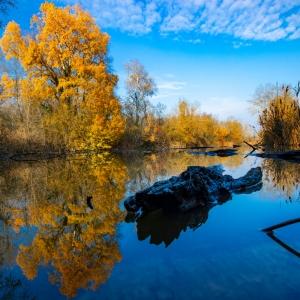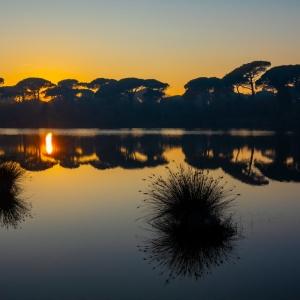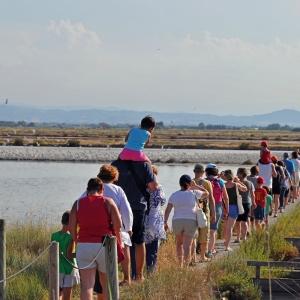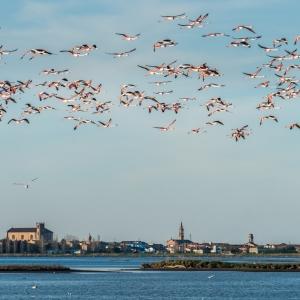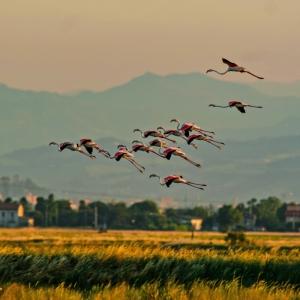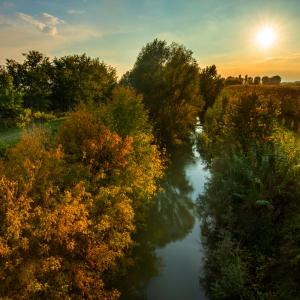BIRDWATCHING PLACES
The area known as Valle Dindona is a flooded-plain of 10 hectares located along the river Po di Goro, between the towns of Goro and Gorino Ferrarese. You can walk or travel by bike along the cycle route on the bank on the right hand side of the Po di Goro, or you can drive along the road that from Goro leads to Gorino Ferrarese, turning left after 3 km from Goro, in Via Vallazza. At the end of the street you can walk on the embankment of the river and from here you can have a beautiful view over the flooded plain.
The vegetation consists of Willows, Poplars and Reeds. In springtime an interesting heronry settles on the trees, it is like a “small town” where different species of herons live and nest on the same trees. This heronry has become particularly interesting in the last few years as herons are joined by Cormorants. The nesting herons are: Grey Herons, Cattle Egrets, Purple Herons, Little Egrets, Night Herons and Squacco Herons. From the bank, on the other side of the plain you can see the paddy fields, cultivated fields, where it is not difficult to spot different species such as Shelduck, Coot, Black-winged Stilt and Montagu’s Harrier.
Features
• Chance of seeing more than 30 species
• Good practicability in case of rain
For your visit
• Open all year round
• Recommended hours: all day
• Duration: minimum two hours
• Accesible for the disables starting from Goro (Via Vincenzo Monti)
Services
• Parking at Goro and Gorino
• Picnic area at Goro and Gorino
• Bicycles rental at Goro and Gorino (port area)
• Boat excursions with tourist operators
• Guided tours by appointment
The Sacca di Goro is a large lagoon enclosed by the branches of the river Po, Po di Goro and Po di Volano, reached by roads that lead to Goro and Gorino Ferrarese. It covers about 3000 hectares and is known for the production of shellfish, especially clams, which find in the bottom of the “sacca” the perfect place to grow and develop. A portion of the lagoon, called “Valle di Gorino”, includes some areas of high natural value, such as reed beds and salt marshes. Along the coast line there is a long strip of sand locally called “scanno” better known as “Island of Love;” the birdwatchers rather like to call it “the island of silters” because of the thousands of waders that stop here wintering. Despite the frequent presence of fishermen, many species are commonly seen throughout the year, in a continuous succession of departures and arrivals. In winter, the lagoon are filled with ducks, very common is also the Black-necked Grebe, and also relatively easy to spot is the Red-breasted Merganser. On sandbanks one can see several waders including Curlew, Whimbrel, Ruddy Turnstone, Dunlin, Grey Plover and Bartailed Godwit only to mention some.
With the change of season also the species coming and going vary: we have the Purple Heron, the Common Tern, the Kentish Plover, the Little Tern, the Avocet, the Black-winged Stilt and the Oystercatcher. It is possible to visit the Sacca di Goro by boat, thanks to many organized boat excursions; but it is also possible to enjoy it from the mainland. The ports of Goro and Gorino are connected by a road that follows the bank, which bans the presence of cars, thus becoming a great route to walk along.
Features
• Chance to see over 50 species
• Observation point at the “Old Lantern”
• Good practicability, possible presence of mud in the rainy periods
For your visit
• Open all year round
• Time recommended: by boat all day, from the bank, in the early morning and late afternoon
• Duration: minimum three hours
• Free path along the bank of the lagoon from Goro to Gorino
• Free path from Gorino up to “Old Lantern”
Services
• Parking at Goro and Gorino
• Picnic area at Goro and Gorino
• Bicycle rent at Goro and Gorino (port area)
• Boat excursions with tourist operators
• Guided tours by appointment
The Mesola Wood is located between the towns of Mesola, Goro and Codigoro and covers an area of 1058 hectares. Because of the characteristics of the soil (small dunes and depressions between them) different types of plants ranging from thermophilic like Holm Oak, to hygrophilous, such as Poplar and Ash can be observed in the wood, in addition to these species one can also find the so-called mesophile plants, represented by the English Oak. There are three routes of different lengths, ranging from one to three hour journey during which you can see the descendants of the ancient population of Red Deer (also known as Stag of the dunes), now joined by a number of Fallow Deer, species of recent introduction. Also interesting is the European Pond Turtle that can easily be seen along the canals that cross the forest. Very commonis the Hermann’s Tortoise, (now subject of a protection program).
The birds located here are specially various kinds of Silvidi such as Blue Tit, Great Tit, Blackcap, Nightingale, Shorttoed Treecreeper, Golden Oriole and Hawfinch… just to name a few. There are then the Great Spotted Woodpecker and Green Woodpecker, Hoopoe and a permanent colony of Common Wood Pigeon. There are also five species of owls living in the woods: the Barn Owl, the Little Owl, the Long-eared Owl, the Tawny Owl and the Scops Owl. The best time to visit the forest is undoubtedly the spring when birds are singing at their maximum.
Features
• Chance of seeing more than 35 species
• Good practicability, possible presence of mud in the rainy periods
For your visit
• Open from March to October on Tuesdays, Fridays, Saturdays
and Sundays from 08.00 to 18.00 (16.00 solar time)
• Recommended hours: early morning and late afternoon
• Duration: minimum two hours
• Access fee
• Some trails are wheelchair accessible
• Path for the blinds
Services
• Parking on payment
• Picnic area
• Guided tours in the area normally closed to the public by appointment
• Guided tours by appointment
• Bicycle rental
Valli Bertuzzi include “Valle Nuova” and “Val Cantone”, they have an extension of about 2.000 hectares and are used for fish farming. They can be easily reached through S.S. Romea 309 following the signs to Lido di Volano or Lido delle Nazioni and from these continuing along Acciaioli road that connects them. Along this road, in front of the holiday village “Spiaggia Romea”, there is a birdwacthing tower that allows a panoramic view over the fishing lagoon and often from here it is possible to see many Greater Flamingos, which move here to feed from the nearby Saline di Comacchio.
Along the external canal of Valle Bertuzzi it is easy to see Coot, Tufted Duck, Pochard, Mute Swan, Cormorant and Pygmy Cormorant. The Lake of Nazioni, which is located south-east of the Acciaioli road, hosts the Great Crested Grebe, Rednecked Grebe (specially in springtime), while in winter it is not uncommon to see even the Black-throated Loon or Smew. In winter we recommend a walk that starts from the Lido delle Nazioni and reaches the beach in front of Spiaggia Romea, allowing one to see waders and seabirds.
Features
• Chance to see over 50 species
• Birdwatching tower
For your visit
• Open all year round
• Recommended hours: morning
• Duration: about one hour
• Free access to the birdwatching tower
• Not accessible for disabled
Services
• Parking at the Lido di Volano and at Lago delle Nazioni
The oasis of Canneviè-Porticino is located along the road that, from the S.S. 309 Romea leads to the Lido di Volano. The oasis, which has an area of 67 hectares, is what remains today of a much larger wetland, drained in the 1950s, and now equipped with a Visitor centre, dining, restaurant and conference center. The route has birdwatching huts and shieldings that allow visitors to spot a good variety of species all year round, including Spotted Redshank, Shelduck, Common Snipe, Kingfisher, Greater Flamingo, Common Teal, Garganey, Mallard and Marsh Harrier.
Starting from Canneviè at the beginning of the path there is a birdwatching hut for a first look at the oasis, following the path you’ll reach a second hut hidden and located in a special area loved by birds. From here you can make the best observations and take good photos as the animals are often very close. Continue in the direction of Porticino to the last birdwatching hut, where, in spring, often you can see the Avocet and the Black-winged Stilt. Also interesting is the stretch of water adjacent (east) to the oasis, in front of the church of Volano, where it is possible to see various waders a few meters from the road.
Features
• Chance of seeing more than 45 species
• Birdwatching huts
• Good usability in case of rain
For your visit
• Area open all year round
• Recommended hours: early morning
• Duration: minimum two hours
• Path with free access from the station Canneviè
• Path accessible for disabled
Services
• Visitor centre, bookstore, dining, hotels, conference center
• Picnic area
• Parking
• Guided tours by appointment
• Bicycle rental
Bonifica del Mezzano e di Valle Pega
Now a vast area of cultivated land, this farm was once part of the Valli di Comacchio and was reclaimed thanks to an impressive project between 1870 and 1900. There are no towns nearby and hunting is not allowed, and thus, sometimes rare species can be observed in this large location. Among the species we can mention Roller, Short-eared Owl, Collared Pratincole, Cranes, not counting the hundreds pairs of Pheasants present. We have the very important presence of Stork, in result of a reintroduction project, of Lapwing and thousands of geese that stop in winter.
The birdwatching is practiced mainly by car along the few paved roads that cross the country from east to west and from north to south, looking at ditches and fields or around the electrical and telephone line where one can spot the following raptors: Hobby, Kestrel and Merlin.
Features
• Chance to see over 45 species
• Good usability in case of rain
For your visit
• Area open all year round
• Recommended hours: all day
• Duration: minimum two hours
• Path accessible for disabled
The Valli di Comacchio extend for about 11.000 hectares and are bounded east by the S.S. Romea 309, south by the river Reno, west by Agosta embankment and north by the town of Comacchio. In the center of Comacchio, in the Street called “Caduti per la Pace”, there is a birdwatching tower that overlooks the large stretch of water called Valle Fattibello. After passing the St. Peter bridge, near the birdwatching tower, you jollow Via Istria end then, keeping to the left, Via Pega Est, until you reach Stazione Foce.
In this site, which is one of the most important areas of the Park, you can go birdwatching along three distinct paths: you can walk on the embankment that leads to the Salt-pans between Valle Spavola and Valle Uccelliera; you can walk or cycle along the path that is on the right just after the iron bridge, until you reach the “Casone Donnabona”; you can take a boat and enjoy a guided tour in the lagoon during which you can also visit the old fishing houses “Casoni Pegoraro and Serilla”. You can also go birdwatching along the nature trail of the “Prato Pozzo” farm and on the southern banks of the Valli di Comacchio on foot, by bicycle or by an electrical bus. The birds of the Valli di Comacchio and Saline are extremely varied but our jewell are the Greater Flamingos that nest in spring and remain resident throughout the year. The Spoonbill, Black-winged Stilt, Oystercatcher, Avocets, Common Tern, Gull-billed Tern, Kentish Plover, Little Tern and several species of gulls, including the Mediterranean Gull arrive in spring to nest. In winter, in addition to many species of waders such as Blacktailed Godwit, Greenshank, Redshank, Grey Plover, Dunlin, it is possible to observe some northern species such as Goldeneye, Red-breasted Merganser or the Short-eared Owl.
Features
• Chance of seeing more than 60 species
• Birdwatching towers and shieldings
• Good usability in case of rain
For your visit
• Hiking trails accessible yearround
• Boat trips from March to October.
• Recommended hours: all day
• Duration: full day
• Boat trips accessible to disabled
Services
• Visitor centre, bookstore, dining, hotels
• Parking
• Picnic area
• Guided tours
• Bicycle rental
• Excursions by boat in the Valli di Comacchio
• Excursions by electrical bus from St. Alberto and Comacchio
Oasi Valle Zavelea e Ansa Fossa
Valle Zavelea is located near the water level regulator named Fosse. From Comacchio it is well signposted and is easily reached by following the signs for Anita. Parking is located on the opposite side of the entrance of the oasis and from there a path leads straight to the birdwatching tower, from which you can practice birdwatching. Valle Zavelea is a basin of fresh water of about 70 hectares adjacent to the Valli di Comacchio, where hunting is banned.
For birdwatchers it is a very interesting area throughout the year round due to the constant presence of numerous species of birds. You can also spot interesting species without leaving the car, stopping on the roadside, especially in late afternoon when you are in favour of light. Above the thick reed beds it is easy to see the Marsh Harrier out hunting, and many species of Ardeidae, Anatidae and many waders. Valle Zavelea is also a nesting site for Black-winged Stilt, Avocet and Collared Pratincole. In winter it is very interesting to watch over the environmental restoration and neighbouring fields,
where you may spot flocks of geese and occasionally even Lapwings.
Features
• Chance to see over 50 species
• Birdwatching tower
• Good usability in case of rain
For your visit
• Open all year round
• Recommended hours: all day
• Duration: minimum two hours
• Not accessible for disabled
Services
• Parking
The site is located near the town of Lido di Spina, and can be reached from the S.S. 309 Romea turning into Via degli Etruschi and then right into Via G. Puccini. You can park near the Lake of Spina and from there you can walk along the path next to the lake and the campsite adjacent to the pine forest. At the end of the path, past the small paved square until you reach the birdwatching tower from which, in the afternoon, when the sun is behind you, one can have an excellent view over the wetlands “Vene di Bellocchio and Ancona”. Back at the small paved square just outside the campsite you can follow the paved way as far as the sea and along the shoreline along the Vene di Bellocchio and Ancona to the mouth of the Reno river.
Valle Ancona is a brackish lagoon of 250 hectares, directly connected with the sea and therefore subject to the influence of the tides. The area is populated by ducks, herons, gulls and terns; at low tide when the sandbanks emerge, the area is crowded with various species of waders including Curlew, Redshank and Greenshank. It is also an important nesting site for the Kentish Plover.
Features
• Chance to see over 30 species
• Birdwatching tower
• Good usability in case of rain
For your visit
• Open all year round
• Recommended hours: in the morning from the beach to Ancona, in the afternoon from the tower
• Duration: minimum three hours
• Path partially accessible for disabled
Services
• Parking
The site is located very close to the town of Argenta, south of the Reno river and can be reached following the coordinates. The site is composed by an area of 600 hectares with fresh water ponds and of a wood 100 hectars large, characterized by two big ponds (“casse di espansione”), Bassarone and Campotto, and finally a reforestation area called the Traversante Wood, with the typical hydrophilous vegetation. Val Campotto is characterized by the presence of one of the largest colonies of Cormorants in Italy. Among the breeding species there are the Whiskered Tern, the Squacco Heron, the Reed Bunting, the Savi’s Warbler, the Great Reed Warbler and the Reed Warbler.
Among migratory birds we must note the Osprey, while the forested area is home to several species of Silvidae such as the Melodious Warbler, the Golden Oriole, the Cuckoo, the Lesser Grey Shrike and the Ortolan Bunting. The site is also known for having hosted, between the years 2006 and 2010, wintering specimens of Greater Spotted Eagle and White-tailed Eagle. To start your visit you should go to the Museo delle Valli Visitors Centre, at the entrance of the Oasis, where you can book a guided tour as the access is regulated. However you can have a walk along a free path outside the Oasis which begins at the Parish of St. Giorgio and arrives fast to the entrance of the Visitors Centre.
Features
• Chance to see over 40 species
• Observation points and birdwatching towers
• Good practicability, possible presence of mud in the rainy periods
For your visit
• Open all year round
• Recommended hours: all day
• Duration: minimum two hours
• Regulated access with guided tours
• Path with free access from the Parish of St. Giorgio to the Visitors centre
• Path largely accessible to disabled
Services
• Visitors centre, museum, bookshop and bar
• Parking
• Picnic area
• Guided tours
• Bicycle rental
• Binoculars rental
Valle Santa is located within walking distance from the Museo delle Valli in the town of Argenta. It is a “cassa di espansione” (overflow) of the Sillaro river 250 hectares large, characterized by reeds and Yellow Water-lily. Outside the overflow is an interesting wet meadow, used by many species for their daily feeding. Valle Santa is one of the best sites for birdwatching in the Po Delta, where you can spot various species of birds: in spring - and summertime there are Caspian Tern, Whiskered Tern and Gull-billed Tern, herons, such as the Little Bittern and the Squacco Heron; in wintertime there are the Great White Egret and Bitterns. In the nearby countryside it is easy to see flocks of Greylag Goose and Crane. Other species found in winter are Teal, Shelduck, the Northern Shoveler and the Common Snipe; more particular species are the Glossy Ibis and the Spoonbill. The cane thickets houses many species such as Bearded Reedling, Penduline Tit, Cetti’s Warbler, Eurasian Reed Warbler and other small birds.
To visit the site, you can walk along the path starting from the parking (where there is a notice board illustrating the oasis) as far as the birdwatching tower from which you can easily see a big part of the wetland. It would be better not to walk on the higher part of the banks so as not to disturb the birds. The best conditions for observation, in order to be favoured by daylight, is in the early morning and in the afternoon until the early evening hours.
Features
• Chance to see over 40 species
• Observation points and birdwatching tower
• Good practicability, possible presence of mud in the rainy periods
For your visit
• Open all year round (the stretch of 6 km is always open, while a 3 km further is open on Thursday, Saturday, Sunday and holidays).
• free access
• Recommended hours: all day
• Duration: 2-3 hours
• Accessible to disabled only if accompanied
Services
• Visitor centre and services in the nearby oasis of Campotto
• Parking
Punte Alberete is a fresh water flooded forest spread over 190 hectares and located north of Ravenna. The area is equipped with a circular path accessible only on foot, starting from the parking place on the the S.S. 309 Romea and leading to the most interesting areas of the site. The trail dips into the flooded forest, characterized by the presence of White Willow and Narrow-leafed Ash, the site also has areas of wet meadow, flooded lowlands with sedge and reed beds and ponds with water dominated by Water Lily. Because of the presence of a big variety of environments Punte Alberete represents the most important ecosystem of the Po Delta Park. In the northern part of the path, well equipped with shielding and a birdwatching hide,
it is possible to observe closely rare species such as Kingfisher, Pygmy Cormorant, Red-crested Pochard. There are many species of Ardeidae and Anatidae that can be spotted. We must also note the important presence of Ferruginous Duck, a beautiful species threatened of extinction on a global level. This can be observed in spring and summer. Also the Glossy Ibis, symbol of the oasis, is visible from April to September.
The trail is accessible all year round and in each season offers unique landscapes. Maybe spring, when many different plants flower and light up the woods with brilliant colours, is, of all times, the best to visit Punte Alberete.
Features
• Chance to see over 50 species
• Birdwatching hut and shielding
• Good usability, presence of mud with abundant rainfall
For your visit
• Open all year round
• Recommended hours: all day
• Duration: minimum two hours and thirty minutes
• Not accessible for disabled
• Regulated admission for groups: for groups with more than 10 persons, you must send a request to the Environment Department - Municipality of Ravenna, Tel +39 0544 482111
Services
• Parking
• Guided tours by appointment
Located between the town of Mandriole and the Lamone river, Valle Mandriole (known as the “Valle della canna”) is a freshwater marsh, which covers about 250 hectares and represents, together with Punte Alberete, the residue of the ancient bed filled by waters of the Lamone river. The area is characterized by waters at different hight levels and with alternating areas of clear deep water to shallow waters; the latter areas are characterized by the presence of Common Reed, Bulrush and Rush lakes, which provide shelter for many species of birds.
From two bridwatching towers, it is possible to have a clear view of the fresh water wetland: one is located near the Lamone river and can be reached directly from the S.S. 309 Romea, the other is located near the Ca ‘del Chiavichino, within walking distance and accessible from the Romea along the Rivalone canal not far from “Tenuta Augusta”. It is possible to go birdwatching in all seasons. During the breeding season from the south birdwatching tower you can see a beautiful heronry with all species of herons of Europe as well as Spoonbill, Glossy Ibis and Pygmy Cormorant. From the birdwatching tower of Ca’ del Chiavichino you can observe the various nesting stages of Coot, Great Crested Grebe and Greylag Goose. There are many Anatidae, which can be spotted in the wetland, Northern Shoveler and Teal, frequent in the steps or wintering; Garganey, widespread in the period March-April; Gadwall, very common during the winter; Pochard and Tufted Duck, observed between January and March and the second half of October. You can enjoy excellent sightings in the early morning hours, but during the spring and summer we suggest visiting the tower in the late afternoon, in order to enjoy a privileged view of the sun setting over the wetlands.
Features
• Chance to see over 50 species
• Birdwathing towers
• Good usability, even in case of rain
For your visit
• Open all year round
• Recommended hours: early morning and late afternoon
• Duration: minimum two hours
• Not accessible for disabled
Services
• Parking
Pineta di San Vitale e Pialassa della Baiona
Of Roman origins, the San Vitale Pinewood is spread over an area of alternating wet lowlands and ancient higher coastal dunes. This alternation of land has enabled the establishment of Italian Stone Pine and Maritime Pine, especially on dunes. You can explore every part of the Pinewood walking or cycling. Immediately behind the Pineta San Vitale lies the Pialassa Baiona, a wetland area of 1.100 hectares: it consists of a brackish water basin which is in connection with the Adriatic sea through the Candiano channel and with fresh water through other channels that flow into the pine forest. The characteristic of Pialassa is to have a constant exchange of water with the sea, thanks to the motion of tides, hence the term “piglia” (take) and “lascia” (loose). There are many Ardeidae, Great White Egrets and Little Egrets. Many species also nest and are easily observable such Shelduck, Common Tern, Black-winged Stilt, Avocet, Redshank and Oystercatcher, while in spring and summer there is a widespread presence of the Greater Flamingo.
You should go to the Pineta San Vitale and the Pialassa della Baiona through the entrance located along the Romea, Ca’ Vecchia, north of the bridge over the Channel Fossatone. You can also reach the Pialassa Baiona from the village Marina Romea. The birdwatching tower located south of the peer at the end of the Viale dei Pioppi, is also an ideal place to make some observations.
Features
• Chance to see over 50 species
• Good usability in case of rain
• Birdwatching tower
For your visit
• Area open all year round
• Recommended hours: all day
• Duration: minimum two hours
• Path accessible for disabled
Services
• Centre for environmental documentation Ca’ Vecchia
• Parking
• Picnic area at the Park “2 Giugno”
• Boat trips
• Guided tours
The Salt-pans of Cervia are the entrance to the south of the Po Delta Regional Park. This environment of great natural interest and beauty has enabled the area to be inserted as a Wetland of International Importance in the Ramsar Convention since 1979 and has thus become a State Natural Reserve. The Salt-pans cover an area of 827 hectares and have a dense network of canals. In terms of salt avifauna the environment is populated by species like the Grater Flamingo, the Black-winged Stilt, the Avocet, and herons. Due to its characteristics, it is a resting and nesting location for numerous species of birds that occupy the small banks and small islands within the area.
Regular nesting species in this site, mostly visible in spring and summer are Shelduck and Mallard among the Anatidae, while among the waders you can observed: the Black-winged Stilt, Avocet, Plover, Lapwing and Redshank. Among the nesting Charadriiformes there are the Gull, the Little Tern and Common Tern. In autumn and winter the area is filled with Wigeons, Teals, Shovelers, Pintails, Gadwalls and Mallards. You can see birds of prey suc as the Marsh Harrier and the Buzzard.
Features
• Possibility to spot 60 species
• Observation points, disguises, towers, huts
• Good usability, even in case of rain
For your visit
• Open from March to November at different times depending on the season
• Recommended hours: early morning and late afternoon
• Duration: minimum two hours and thirty
• Access fee
• Partially wheelchair accessible routes
Services
• Visitor centre, museum and bookshop
• Parking
• Refreshment
• For guided tours can hire binoculars and bicycles
Ortazzo, Ortazzino e foce del Torrente Bevano
The river mouth Bevano is characterized by an estuary. The mouth, enclosed in an area of 1256 hectares, with its dunes and coastal lagoons is a photograph of the coastal environment before the intervention of man. On the west of the mouth is an area called Bevano dell’Ortazzino consiststing of fossil meanders of the river, wet meadows and ancient coastal dunes with groundwater outcropping. Wet meadows adjacent to this area, wetlands deriving from old rice fields, and fish farms today see the intrusion of salt water. The variety and complexity of the environments makes this site rich in biodiversity, flora and fauna. Ortazzo and Ortazzino area has a large community of nesting Charadriiformes, such as Black-headed Gull and Slender-billed Gull and a strong presence of waders as Black-winged Stilt, Avocet, Redshank and Kentish Plover. There is a remarkable presence of Anatidae, such as the Common Shelduck, currently being expanded; occasionally nesting are Garganey and Common Teal. As for the coastal environment, affected strongly by human presence, the only species visible in fairly large numbers is the Kentish Plover. As for the Passeriformes we must report the presence of Tawny Pipit, a species breeding in very low numbers on the dunes of Ortazzino.
The Mouth of Bevano, the Ortazzino and Ortazzo are easy to reachd by car from the S.S. 16 Adriatica. The sightings are possible thanks to the presence of two birdwatching towers, one in the Ortazzino and one in the western part of Ortazzo, where there is also a birdwatching hut.
Features
• Chance to see over 50 species
• Birdwatching towers and huts
• Good practicability, possible presence of mud in the rainy periods
For your visit
• Open all year round
• Recommended hours: early morning and late afternoon
• Duration: minimum two hours
• Free access
• Partial path with easy access for disabled
Services
• Guided tours by appointment
• Visitor centre and services in nearby Salina di Cervia



